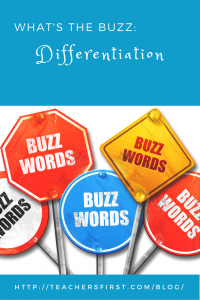 Differentiation is one of those terms that teachers have heard a lot about over the years, but I still hear confusion over the term when I talk to other educators. Depending on their teaching situation, educators can get stuck on a single dimension of differentiation. Some think it means catering to a student’s learning profile – understanding how they best take in information. Are they visual, auditory or tactile/kinesthetic learners? Others believe that differentiation means adapting the content in some way to meet the learner’s needs. While both approaches address differentiation, neither fully explains how to go about making sure that classroom content is differentiated.
Differentiation is one of those terms that teachers have heard a lot about over the years, but I still hear confusion over the term when I talk to other educators. Depending on their teaching situation, educators can get stuck on a single dimension of differentiation. Some think it means catering to a student’s learning profile – understanding how they best take in information. Are they visual, auditory or tactile/kinesthetic learners? Others believe that differentiation means adapting the content in some way to meet the learner’s needs. While both approaches address differentiation, neither fully explains how to go about making sure that classroom content is differentiated.
Differentiation is an idea with a number of dimensions. If you leave any one of those pieces out of your definition, then you are not truly prepared to plan to teach in a way that effectively responds to the individual needs of your students. To fully understand differentiation, teachers must understand the principles that guide the practice including flexible grouping, continual assessment, and building community. Additionally, there is a need to grasp the various pathways to differentiation such as content, process, product, and the learning environment. The process is driven by student readiness, interests, and learning profile. It is sometimes hard to imagine all of the moving parts that must come together in a differentiated lesson. This diagram is one of the best representations of differentiation that I have seen. It explains the different pieces of differentiation and their relationship to each other.
There are a number of places to find out more about differentiation and how you can put it into practice in your classroom. ASCD has a free webinar archive that features Carol Ann Tomlinson that is helpful. Additionally, TeachersFirst has a resource page that suggests strategies and resources for differentiating content. If you have any favorite resources that help explain differentiation, let us know in the comments.


2 thoughts on “What’s the Buzz: Differentiation”